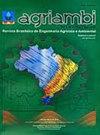鱼养殖含盐废水灌溉下的樱桃番茄产量和种子活力
IF 1.4
4区 农林科学
Q3 AGRICULTURAL ENGINEERING
Revista Brasileira de Engenharia Agricola e Ambiental
Pub Date : 2021-06-01
DOI:10.1590/1807-1929/AGRIAMBI.V25N6P380-385
引用次数: 5
摘要
本研究旨在评价不同物候期养鱼盐水出水灌溉对樱桃番茄果实产量和种子活力的影响。Mossoro实验是在温室进行,RN,巴西,使用一个完全随机设计10治疗,包括使用的鱼类养殖废水的电导率(EC) dS 4.54 m - 1与EC dS 0.54 m - 1和城市供应水,交替在四个物候阶段(移植后增长从1到19天(DAT),从20 - 31 DAT开花,水果馅从32到60 DAT和成熟从61年到77年DAT)。在整个樱桃番茄物候期施用养鱼产生的含盐废水不会减少每束果实的产量,但会减少种子的产量和种子的活力。在养鱼初期和成熟阶段使用含盐废水,连续两次使用含盐废水,交替使用低盐度水灌溉,有利于生产具有良好活力的樱桃番茄种子。交替施用鱼类养殖的含盐废水,随后连续两次用低盐度水灌溉,尽管减少了种子产量,但有利于高产种子。在开花期和结实期使用鱼类养殖的含盐废水会减少种子的产量和产生的种子的活力。本文章由计算机程序翻译,如有差异,请以英文原文为准。
Cherry tomato production and seed vigor under irrigation with saline effluent from fish farming
This study aimed to evaluate the effect of irrigation with saline effluent from fish farming in different phenological stages on fruit production and seed vigor of cherry tomato. The experiment was conducted in a greenhouse in Mossoró, RN, Brazil, using a completely randomized design with 10 treatments, which consisted of the use of fish farming effluent with electrical conductivity (EC) of 4.54 dS m-1 and public-supply water with EC of 0.54 dS m-1, alternated during four phenological stages (growth from 1 to 19 days after transplantation (DAT), flowering from 20 to 31 DAT, fruit filling from 32 to 60 DAT and maturation from 61 to 77 DAT). Application of saline effluent from fish farming throughout a phenological stage of cherry tomato does not reduce fruit production per bunch, but reduces seed production and the vigor of the seeds produced. The use of saline effluent from fish farming in the initial and maturation stages, and the use of effluent with two successive applications, alternated with irrigation with low salinity water, are favorable for the production of cherry tomato seeds with satisfactory vigor. Alternated application of saline effluent from fish farming, with two subsequent successive irrigations with low-salinity water, despite reducing seed production, favors the production of seeds with high vigor. The use of saline effluent from fish farming in the flowering and fruiting stages reduces seed production and the vigor of the seeds produced.
求助全文
通过发布文献求助,成功后即可免费获取论文全文。
去求助
来源期刊

Revista Brasileira de Engenharia Agricola e Ambiental
Agricultural and Biological Sciences-Agronomy and Crop Science
CiteScore
2.70
自引率
16.70%
发文量
114
审稿时长
3-8 weeks
期刊介绍:
A Revista Brasileira de Engenharia Agrícola e Ambiental (Agriambi), periódico oficial da Asociación Latinoamericana y del Caribe de Ingeniería Agrícola (ALIA), é editada mensalmente, no formato eletrônico, pela Unidade Acadêmica de Engenharia Agrícola (UAEA) do Centro de Tecnologia e Recursos Naturais (CTRN) da Universidade Federal de Campina Grande (UFCG), destinando-se à divulgação de artigos científicos originais e inéditos, elaborados em Português, Inglês ou Espanhol. Com o auxílio de pareceres de Consultores, os artigos são aceitos ou não pela Equipe Editorial para publicação na Revista. A Agriambi aceita, também, a submissão de contribuições na modalidade de revisão de literatura.
 求助内容:
求助内容: 应助结果提醒方式:
应助结果提醒方式:


